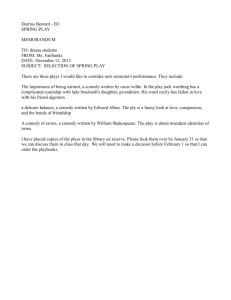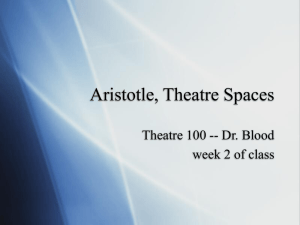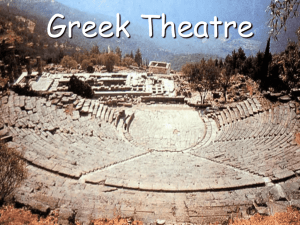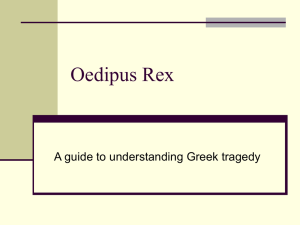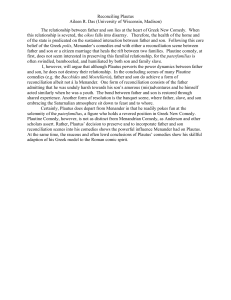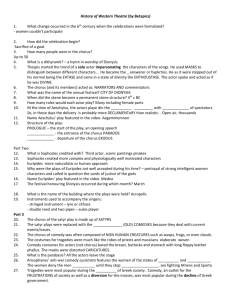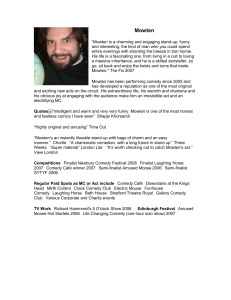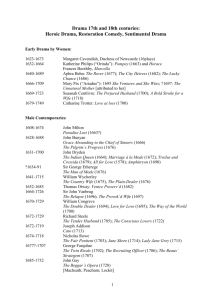Dramatic Introduction (2)
advertisement
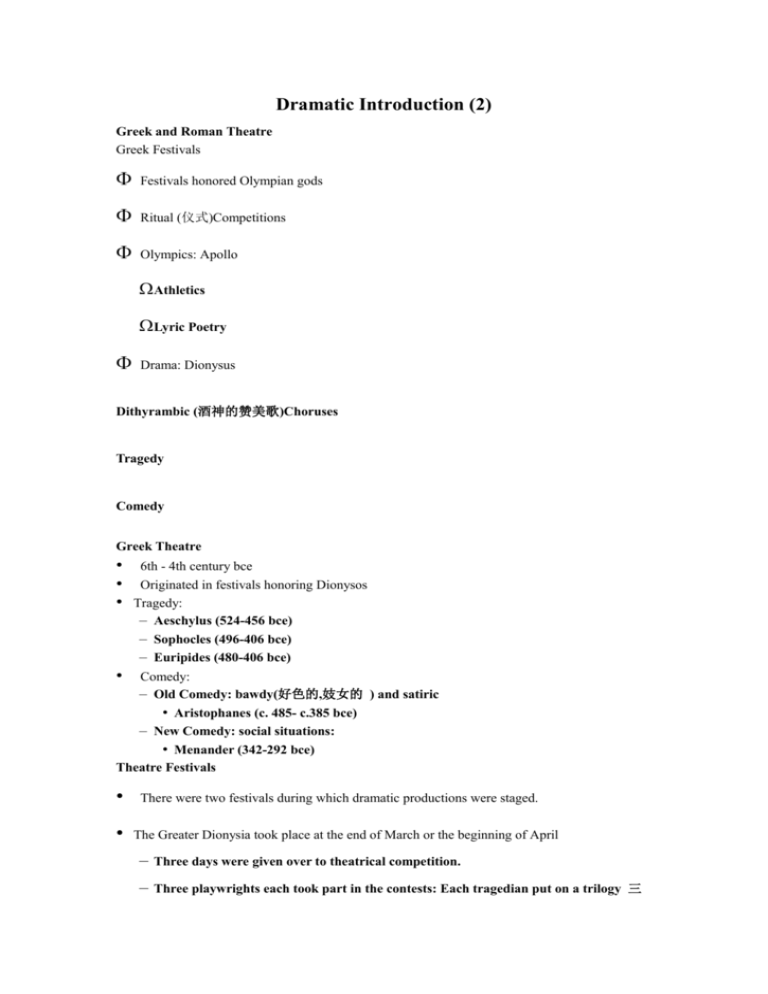
Dramatic Introduction (2) Greek and Roman Theatre Greek Festivals Festivals honored Olympian gods Ritual (仪式)Competitions Olympics: Apollo Athletics Lyric Poetry Drama: Dionysus Dithyrambic (酒神的赞美歌)Choruses Tragedy Comedy Greek Theatre • • • • 6th - 4th century bce Originated in festivals honoring Dionysos Tragedy: – Aeschylus (524-456 bce) – Sophocles (496-406 bce) – Euripides (480-406 bce) Comedy: – Old Comedy: bawdy(好色的,妓女的 ) and satiric • Aristophanes (c. 485- c.385 bce) – New Comedy: social situations: • Menander (342-292 bce) Theatre Festivals • • There were two festivals during which dramatic productions were staged. The Greater Dionysia took place at the end of March or the beginning of April – Three days were given over to theatrical competition. – Three playwrights each took part in the contests: Each tragedian put on a trilogy 三 联曲/三部曲in the morning and each comic writer put on one comedy in the afternoon. ACTORS No play used more than 3 actors All actors were male Costumes included character masks, and, in later years, raised boots Acting must have more expressive than realistic ORIGINS of TRAGEDY Tragedy, derived from the Greek words tragos (goat) and ode (song), told a story that was intended to teach religious lessons Arose from dithyrambic choruses: The dithyramb was an ode to Dionysus. It was usually performed by a chorus of fifty men dressed as satyrs 半人半兽的森林之神-- mythological half-human, half-goat servants of Dionysus. In 600 BC, formal lyrics were written for the dithyramb. In the 6th c. bce Thespis 悲剧of Attica added an actor who interacted with the chorus. This actor was called the protagonist. In 534 BC, the ruler of Athens, Psistratus, changed the Dionysian Festivals and instituted drama competitions. Thespis won the first competition in 534 BC. Tragic Tetralogies Each tragic dramatist had to present a trilogy of tragedies: connected narratively or dramatically The entire trilogy was performed in one day. The trilogy was followed by a satyr play - mocking and lightening the seriousness of the tragedies TRAGIC STRUCTURE ARISTOTLE’S THREE UNITIES Aristotle’s On Tragedy is usually considered the first piece of Western dramatic criticism. it, he proclaimed that tragedy must follow the 3 unities: UNITY OF TIME: one day UNITY OF PLACE: one setting UNITY OF ACTION: one plot AESCHYLUS 525-456 bce General in Persian Wars -- fought at Marathon, Salamis, Plateau Fierce proponent 支持者of Athenian ideals The first of the great Athenian dramatists, was also the first to express the agony of the individual caught in conflict. Credited with adding the second actor Only extant trilogy: The Oresteia 俄瑞斯提亚 Agamemnon 阿伽门农 The Libation Bearers 奠酒人 The Eumenides报仇神 In SOPHOCLES 496 - 406 bce Wrote over 100 plays, but only seven survive Credited with adding the third actor Known as actor as well as dramatist Most interested in human dynamics THEBAN PLAYS: Oedipus the King 俄狄浦斯王 Oedipus at Colonnus俄狄浦斯在科洛诺斯 Antigone 安提戈涅 EURIPIDES c.480-406 bce The last of the three great Greek tragic dramatists –more than 90 tragedies, 17 plays survive. Medea is his famous drama. Explored the theme of personal conflict within the polis 城帮and the depths of the individual Disgust with events of Peloponnesian War brought about disillusionment with Athens Men and women bring disaster on themselves because their passions overwhelm their reason ORIGINS of OLD COMEDY Arose from komos : songs of revelry 狂欢, charms to avert 转移evil, prayers for fertility sung to Dionysus Chorus dressed ludicrously滑稽可笑的 Audience responded to choral komos and were gradually admitted into chorus Chorus became two-part group with antiphonal发出语音的 song Invention of comic chorus is attributed to Susarion Dorian and Sicilian farces闹剧 were precursors 先行者of Old Comedy CONVENTIONS of OLD COMEDY Scene set on Athenian street “Events seldom occur – they are merely talked about” Masks and fantastic costumes Satiric of contemporary events and public figures Bawdy ARISTOPHANES c. 448 - 380 BCE 30+ plays; 11 extant; 6 first prizes Plays include Clouds, Wasps,Birds, Frogs, Lysistrata Critique of Euripides & Socrates: reactionary conservative; social critic Plato‘s epitaph 墓志铭for Aristophanes : “The Graces, seeking a shrine that could not fall, discovered the soul of Aristophanes.” New Comedy By 317 BC, a new form had evolved that resembled modern farces 笑剧: mistaken identities, ironic situations, ordinary characters and wit. Basic plot: Boy meets girl, complications arise, boy gets girl – ends with betrothal订婚 or marriage. 5 act structure: acts divided by interludes performed by the chorus Stock characters: young lovers, parasite, lecherous old men, clever servants, etc. Social rather than political satire MENANDER 342-292 bce 1905 a manuscript was discovered in Cairo with pieces of five of Menander’s plays, and in 1957 a complete play, Diskolos (The Grouch, 317 BC), was unearthed in Egypt. The style of comedy that Menander created, with its emphasis on mistaken identity, romance and situational humor, became the model for subsequent comedy, from the Romans to Shakespeare to Broadway. Parts of his comedies found their way into plays by the Roman playwrights Plautus and Terence, Shakespeare's Comedy of Errors, Stephen Sondheim's A Funny Thing Happened on the Way to the Forum. ROMAN THEATRE Drama flourished under the Republic but declined into variety entertainment under the Empire Roman festivals: Held in honor of the gods, but much less religious than in Greece Ludi Romani Became theatrical in 364 B.C. Held in September (the autumn)and honored Jupiter. By 240 B.C., both comedy and tragedy were performed. Five others: Ludi Florales (April), Plebeii (November), Apollinares (July), Megalenses (April), Cereales (no particular season). Under the Empire, these festivals afforded "bread and circuses" to the masses – many performances. —including a series of plays or events. Acting troupes (perhaps several a day) put on theatre events. ROMAN THEATRE Encompassed more than drama : acrobatics杂技, gladiators角斗士, jugglers变戏法者, athletics体育, chariots races, naumachia (sea battles), boxing, venationes (animal fights) Entertainment tended to be grandiose宏伟的, sentimental, diversionary娱乐的 Actors / performers were called "histriones" STOCK CHARACTERS Senex: old man in authority Pappas: foolish old man Bucco: braggart吹牛的, boisterous Miles gloriosus: braggart soldier Dossenus: swindler骗子, drunk, hunchback驼背 Shrew: sharp-tongued woman Courtesan Clever servant Young Lovers PLAUTUS (c. 254-184 B.C.E.) 21 extant plays including Pot of Gold, The Menaechmi, Braggart Warrior -- probably between 205-184 B.C. All based on Greek New Comedies Added Roman allusions, Latin dialog, varied poetic meters, witty jokes Some techniques: Stychomythia – dialog with short lines, like a tennis match Slapstick 闹剧 Songs TERENCE (195 or 185-159 B.C.E.) Born in Carthage, came to Rome as a boy slave, educated and freed The Afer in his name may indicate that he was an African, and therefore he may have been the first major black playwright in western theater. Six plays, all of which survive including The Brothers, Mother-in-Law, etc. More complex plots – combined stories from Greek originals. Character and double-plots were his forte – contrasts in human behavior Less boisterous 活跃的,喧闹的than Plautus, less episodic, more elegant language. Less popular than Plautus. Roman Tragedy None survive from the early period, and only one playwright from the later period: Lucius Annaeus Seneca 5 act structure – later adopted by Elizabethans Elaborate speeches -- rhetorical influence Interest in morality – expressed in sententiae (short pithy generalizations about the human condition) SENECA (5 or 4 B.C.E.– 65 C.E.) Nine extant tragedies, five adapted from Euripides:The Trojan Women, Media, Oedipus, Agamemnon His popularity declined, Suicide in 65 A.D.– at the orders of Nero Seneca had a strong effect on later dramatists. Probably closet dramas—meant to be read to an audience rather than performed Senecan Conventions • Violence and horror onstage (Jocasta rips open her womb子宫, for example) • Characters dominated by a single passion – such as revenge – drives them to doom: known as Senecan Revenge tragedies during Renaissance. • Technical devices: – Soliloquies and asides – Confidants take the place of the chorus – Ghosts: interest in supernatural and human connections Roman Spectacle Gladiatorial combats角斗士格斗 Chariot races 战车比赛 Naumachia: Naval battles in a flooded Coliseum “Real-life” theatricals Decadent颓废的, violent and immoral All theatrical events banned by Church when Rome became Christianized
